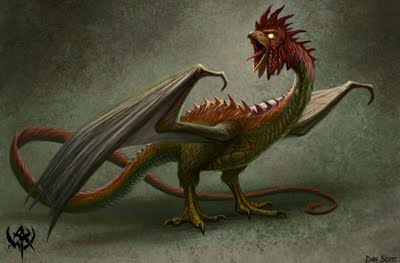By Alan McCoy from Dungeons & Dragons: Fundamentals
How to build challenging
encounters against a Cockatrice
Note: This has been prepared utilizing only the 5E Core Rules. The Cockatrice can be found in the Monster Manual page 42.
The Cockatrice is a small, monstrosity. In physical terms, an adult weighs roughly fifteen pounds on average, stands about three feet tall and has a wingspan of seven to eight feet. They are a perverse crossbreed with elements of bird, lizard, and bat. Most describe these creatures as being a large chicken with bat wings and a lizard’s tail. Many Alchemists state that much of the body of a cockatrice is useful as a magical ingredient, though exactly what parts and exactly how they are used are not common knowledge.
It is suspected that these creatures were created to provide the aforementioned useful ingredients but were somehow released to the wild. Rather than suffer the quick extinction that such a fate would doom almost all other monstrosities too, the cockatrice survived.
In the wild these creatures are omnivores with a diet consisting of berries, nuts, plants and other small creatures (insects, mice, frogs and the like). They are generally not aggressive unless attacked or otherwise frightened. If possible, they will simply fly away. The cockatrice tends to nest in pairs, but there have been reports of groups at ten or more reported. An unconfirmed report of a group of ‘more than a hundred of the beasts’ has been heard, though the reporter turned to stone before he could be further questioned.
The major danger to be had from the Cockatrice is its temperamentality and the ability for even the smallest of pecks from its beak cause flesh to turn to stone. If the cockatrice or any member of its flock is injured or seriously threated, the cockatrice goes into a frenzy, charging whatever caused the fright or injury until either they or it are dead.
Step 1) Let’s Review what we know about the Cockatrice?
They can fly, up to 40 feet/round. If they walk, they can move at 20ft/round.
They have Darkvision 60 feet. Passive Perception 11 (NOT RAW: I increase this to 16 as they have 270 degrees of vision)
Cockatrice are Weak, Stupid and have very little in the way of the ‘Cute Factor’, they are quick, tough and have a strong will to live.
Step 2) Determine the probable Strategy
As far as humanoids are concerned, the primary motivation of a Cockatrice to be left alone, as such they tend to nest in inaccessible areas such as sea cliffs or tall trees.
Step 3) Determine Tactics
Just to turn it up a notch, an attacking cockatrice will make it’s primary attack with it’s beak each round, and make a bonus attack with its claw (d20+0, damage: 1+1 (Dexterity) finesse.
All the creatures will attack the person that frightened them or attacked them. Every attack in the first round will be directed against that individual.
In subsequent rounds, as more character’s attack, they will break off and attack them as well.
Step 4) DM Tips and Observations
One of the primary benefits for a DM in using a group of these creatures early in your players careers, is that it shows the capability of concentrated attacks.
